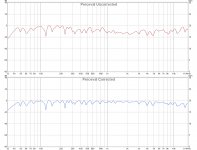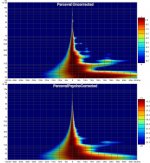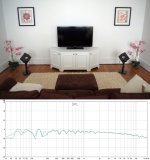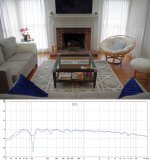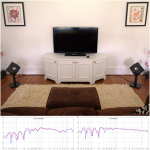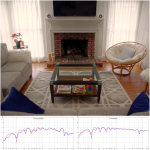The IR looks good, but it's mono. Is this a 2 channel average, or just a single speaker?
Anyway, I made a filter for it. HF target = LinTilt3, and LF target = HP40-24.
I think you sit further away than I do, so this may be a touch "bright".
Filter link in post #1; I'll delete it eventually after you grab it.
Anyway, I made a filter for it. HF target = LinTilt3, and LF target = HP40-24.
I think you sit further away than I do, so this may be a touch "bright".
Filter link in post #1; I'll delete it eventually after you grab it.
Attachments
Ha... yes.
This was the sweep with both speakers.
And I sit about 3.5m away from the speakers.
I'm sorry. I have had a zillion things on my mind lately. Been building a shed to protect my tools from typhoons, and was in a hurry to do so before leaving on vacation in 4 days.
Plus all the little things to consider before leaving...
My mind hasn't been in audio space lately. I haven't fired up the system in 4 days... which is very unlike me. I always need music surrounding me, but I've been so busy to realize there was no music.
I just picked up the file, thanks!
I'll still give it a shot... I'm intrigued.
I just hope I have time before I leave. I'll find the time!
This was the sweep with both speakers.
And I sit about 3.5m away from the speakers.
I'm sorry. I have had a zillion things on my mind lately. Been building a shed to protect my tools from typhoons, and was in a hurry to do so before leaving on vacation in 4 days.
Plus all the little things to consider before leaving...
My mind hasn't been in audio space lately. I haven't fired up the system in 4 days... which is very unlike me. I always need music surrounding me, but I've been so busy to realize there was no music.
I just picked up the file, thanks!
I'll still give it a shot... I'm intrigued.
I just hope I have time before I leave. I'll find the time!
24 hours before leaving! Had a quick session.
Things seemed well centered, and instruments panning as they should.
It is a bit more shimmering than what I am used to listen to. Voices became "nasal" and lacked dept. Also, I run my big 15" woofers down to 35Hz before high passing them slowly. So, it was missing a lot of deep end that I usually have.
Thanks for sending me the file.
When I come back, I will try chasing down the gremlins in my PC that are preventing me from running the DRC software.
See ya all in a month!
Things seemed well centered, and instruments panning as they should.
It is a bit more shimmering than what I am used to listen to. Voices became "nasal" and lacked dept. Also, I run my big 15" woofers down to 35Hz before high passing them slowly. So, it was missing a lot of deep end that I usually have.
Thanks for sending me the file.
When I come back, I will try chasing down the gremlins in my PC that are preventing me from running the DRC software.
See ya all in a month!
Cool, thanks for the update. If we try again at some point, let's definitely use separate L/R sweeps. In my system, I got the sharpest phantom center to date with this method (possibly due to the matching response envelopes?). Also, I think it's possible that the excess phase removal could work better with single speaker measurements.
I think the response you sent me dropped sharply below ~40Hz, so we should also make sure system config/x-over/eq is consistent. Then we can fine-tune.
Enjoy your trip!
I think the response you sent me dropped sharply below ~40Hz, so we should also make sure system config/x-over/eq is consistent. Then we can fine-tune.
Enjoy your trip!
Hi,
If you made it to part 2, you're doing very well . The tough part is fussing about the impulse center locations; you could try ignoring those steps and see if you get good results.
. The tough part is fussing about the impulse center locations; you could try ignoring those steps and see if you get good results.
After that, it's pretty straight forward. Configuration files are named something like "minimal-44.1.drc", and should be edited as needed with a text editor (notepad/wordpad), while scripts should run with a simple double click once everything is in place.
Let me know if you have a specific question.
If you made it to part 2, you're doing very well
After that, it's pretty straight forward. Configuration files are named something like "minimal-44.1.drc", and should be edited as needed with a text editor (notepad/wordpad), while scripts should run with a simple double click once everything is in place.
Let me know if you have a specific question.
Aaah! 
Thanks, now I got it to work! Only tried it so far on my desktop setup which I rarely use nowadays and there is a clear audible difference. Not so sure though if I like it better or not. Also, maybe I should unplug my MiniDSP and do new measurements without the EQ-filters that are currently active. Guess I get better results that way.
So, this convolver works through Foobar2000 but is there any way I can measure the new response with REW? It would be interesting to measure the difference!
And now I just need to learn how to use RePhase and set up my MiniDSP OpenDRC for the big stereo...
Edit: Did a quick listen to some various types of music. It's late at night and I don't want to disturb my neighbours so I'll have to wait till tomorrow to really turn up the volume. But anyways, the sound did get "darker" and something weird happened to the lower midrange. The speakers are CSS EL70 4" full-range drivers. I once took the speakers to the local hifi-store because the guys working there wanted to have a listen to them (and I wanted to try them with fancy amplifiers). They thought they sounded quite "nasal" and "woody". The filter completely removes this character. Listen to "Highway 29" by Bruce Springsteen. He has a quite rough and breathy voice and this gets a little over exaggerated with these speakers but the filter brings it down to normal. Now that I know how to do I think I'll try it on the big stereo tomorrow and see what it can do.

Thanks, now I got it to work! Only tried it so far on my desktop setup which I rarely use nowadays and there is a clear audible difference. Not so sure though if I like it better or not. Also, maybe I should unplug my MiniDSP and do new measurements without the EQ-filters that are currently active. Guess I get better results that way.
So, this convolver works through Foobar2000 but is there any way I can measure the new response with REW? It would be interesting to measure the difference!
And now I just need to learn how to use RePhase and set up my MiniDSP OpenDRC for the big stereo...
Edit: Did a quick listen to some various types of music. It's late at night and I don't want to disturb my neighbours so I'll have to wait till tomorrow to really turn up the volume. But anyways, the sound did get "darker" and something weird happened to the lower midrange. The speakers are CSS EL70 4" full-range drivers. I once took the speakers to the local hifi-store because the guys working there wanted to have a listen to them (and I wanted to try them with fancy amplifiers). They thought they sounded quite "nasal" and "woody". The filter completely removes this character. Listen to "Highway 29" by Bruce Springsteen. He has a quite rough and breathy voice and this gets a little over exaggerated with these speakers but the filter brings it down to normal. Now that I know how to do I think I'll try it on the big stereo tomorrow and see what it can do.
Last edited:
I updated my customized configuration files. This "recipe" is both a bit more conservative and minimalist. It reflects what I have found to work pretty well so far in my new rooms, and I think is more in keeping with the original intent of a "room compensated speaker filter". Prefiltering is 4 cycles, and filter resolution (freq response envelope inversion) is ERB scale. The target response is applied by two stages, and uses a combination of a (typical) log tilt for overall freq balance, and a linear tilt for treble response. This seems to do a nice job of both helping to avoid the excessive use of either target type, and mimicking a natural in-room speaker response. The target response used for the results shown comes from a -3dB@22kHz log tilt, and a -7dB@22kHz lin tilt. The filtering is minimum phase throughout.
Attachments
For convolution users out there, especially Mac since getting a convolution plugin is not so easy, there's a new plugin out there. And the best, it's free.
Allows you to import your own impulse, and play with timing delay, etc...
Initial tests seems to be limited to 48kHz or lower, so if you have tracks that are 96kHz and above, it induces a click on the track.
Available for both Mac and PC.
And again, it's free!
Convology XT - Impulse Record
Allows you to import your own impulse, and play with timing delay, etc...
Initial tests seems to be limited to 48kHz or lower, so if you have tracks that are 96kHz and above, it induces a click on the track.
Available for both Mac and PC.
And again, it's free!
Convology XT - Impulse Record
I would like to point out that REW has a merge function, which I found very helpful. For instance I like the ERB filter, but find it a bit weak in the bass department. So I merge the ERB filter with a NORMAL filter at 100 hz. That way I get the best of everything from both filters. At least that has worked for me. Feel free to experiment 
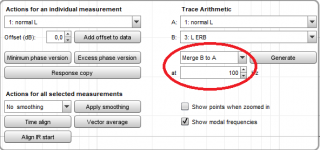

Not dumb at all, sorry for the confusion. The "4 cycles" config was part of a custom set of configuration files that is not currently included with the package. You can get close to it with the standard "minimal" config (5 cycles) with the psychoacoustic target stage bypassed. If there is something specific you want, let me know and I'll create/upload it for you.
On another note, I've been playing with my customized freq response envelope EQ config - pushing it further in the direction of a "speaker filter" for single point measurements, and will upload it soon.
On another note, I've been playing with my customized freq response envelope EQ config - pushing it further in the direction of a "speaker filter" for single point measurements, and will upload it soon.
Custom "psychofilter" package has been updated to my latest attempt at an automated method for creating a psychoacoustic based "room compensated speaker filter".
The prefiltering procedure extracts the min phase response from the impulse response and applies a fairly sharp 3.6 cycle FDW (1/5 oct frequency domain resolution). Next, Bark resolution EQ is used to flatten the magnitude response envelope, and a target response is applied. I have found the classic B&K target to compliment the final response, and have included it as the default. Peak limiting/gain is somewhat self regulated, since any significant boost in the lower octaves would likely cause a FR bump (given the low Q factor of the filter in the low freq region) which the psychoacoustic target stage simply won't allow. For this reason PLMaxGain is set to its maximum value.
Results shown are with otherwise filterless sealed single driver speakers using the default parameters. FR graphs are 9 oct (32Hz-16.4kHz).
The prefiltering procedure extracts the min phase response from the impulse response and applies a fairly sharp 3.6 cycle FDW (1/5 oct frequency domain resolution). Next, Bark resolution EQ is used to flatten the magnitude response envelope, and a target response is applied. I have found the classic B&K target to compliment the final response, and have included it as the default. Peak limiting/gain is somewhat self regulated, since any significant boost in the lower octaves would likely cause a FR bump (given the low Q factor of the filter in the low freq region) which the psychoacoustic target stage simply won't allow. For this reason PLMaxGain is set to its maximum value.
Results shown are with otherwise filterless sealed single driver speakers using the default parameters. FR graphs are 9 oct (32Hz-16.4kHz).
Attachments
Thanks for the clarification. I've read through the thread and have all sorts of dumb/not dumb questions. I want to get a good understanding off what is going on so I'm not just shooting in the dark. For starters, what is the psychoacoustic target stage - I'm guessing this is where the frequency response is tailored to give a required balance?
As to my requirements, I'm not really sure at the moment. Subjectively my system is pretty well balanced with decent resolution. I'd like more precise imaging though, and more depth. Is this related to any specific technical parameters? I'm imagining a cleaner impulse response that is precisely matched between channels should help.
As to my requirements, I'm not really sure at the moment. Subjectively my system is pretty well balanced with decent resolution. I'd like more precise imaging though, and more depth. Is this related to any specific technical parameters? I'm imagining a cleaner impulse response that is precisely matched between channels should help.
The psychoacoustic target stage creates an EQ curve which will flatten the "envelope" of the frequency response; basically it sees peaks as carrying much more weight than dips. In the standard configurations this is applied with erb resolution to the *unwindowed corrected* response. In my current "psycho" config, it is applied with Bark resolution to the *windowed uncorrected* response, and it serves as the sole correction stage.
"Precise imaging" or, to me, making mono recordings sound more like they emerge from a single center speaker, is probably the result of matching the perceived response of each speaker. Here is where I feel that targeting the frequency response envelope can be effective, especially when the speaker/room setup has a high degree of symmetry. Impulse response correction can certainly achieve this, but I think it generally requires a higher degree of resolution which carries an increased risk of artifacts away from the measurement point.
Imaging "depth" is probably more related to frequency balance; I think the general consensus here is that a downward sloping response increases the perceived depth. This is fairly easy to experiment with. Also, having a certain amount of physical space around and especially behind the speakers may help here.
The reasoning behind the "room compensated speaker filter" is pretty much as you speculate, with the additional hope of appealing more to people who are skeptical of "room EQ", and especially doing so with a single point measurement. I do hope to get some feedback on this...
"Precise imaging" or, to me, making mono recordings sound more like they emerge from a single center speaker, is probably the result of matching the perceived response of each speaker. Here is where I feel that targeting the frequency response envelope can be effective, especially when the speaker/room setup has a high degree of symmetry. Impulse response correction can certainly achieve this, but I think it generally requires a higher degree of resolution which carries an increased risk of artifacts away from the measurement point.
Imaging "depth" is probably more related to frequency balance; I think the general consensus here is that a downward sloping response increases the perceived depth. This is fairly easy to experiment with. Also, having a certain amount of physical space around and especially behind the speakers may help here.
The reasoning behind the "room compensated speaker filter" is pretty much as you speculate, with the additional hope of appealing more to people who are skeptical of "room EQ", and especially doing so with a single point measurement. I do hope to get some feedback on this...
Thanks for the explanation of the psychoacoustic target stage .
I've certainly found having more space behind the speakers increases a sense of depth, but I'm limited by room space.
My thoughts around soundstaging are prompted at least in part by subjective reports of the effects of DRC tools such as Dirac and Acourate. On an objective level, I'm thinking it is to do with reducing early reflections, but you say better resolution is required for this. Are you referring to the number of cycles of correction, and if so how many do you think are required for an improved impulse response? Do the number of taps used have an effect?
I've certainly found having more space behind the speakers increases a sense of depth, but I'm limited by room space.
My thoughts around soundstaging are prompted at least in part by subjective reports of the effects of DRC tools such as Dirac and Acourate. On an objective level, I'm thinking it is to do with reducing early reflections, but you say better resolution is required for this. Are you referring to the number of cycles of correction, and if so how many do you think are required for an improved impulse response? Do the number of taps used have an effect?
- Home
- Loudspeakers
- Full Range
- A convolution based alternative to electrical loudspeaker correction networks
